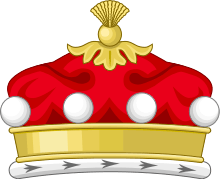Baron Churston
Baron Churston, of Churston Ferrers and Lupton in the County of Devon, is a title in the Peerage of the United Kingdom. It was created in 1858 for the former Conservative Member of Parliament, Sir John Yarde, 3rd Baronet.[2] He had earlier represented South Devon in the House of Commons. Two years later, in 1860, he assumed by Royal licence the additional surname of Buller. As of 2014 the titles are held by his great-great-great-grandson, the fifth Baron, who succeeded his father in 1991.

The Baronetcy, of Lupton House in the County of Devon, was created in the Baronetage of Great Britain on 13 January 1790 for the lawyer Sir Francis Buller.[3] He was the son of James Buller. The first Baronet's son, the second Baronet, represented Totnes in the House of Commons. In 1800, he assumed by Royal licence the surname of Yarde. He was succeeded by his eldest son, the aforementioned third Baronet, who was elevated to the peerage in 1858.
The Barons Churston are related to the Viscounts Dilhorne and the Aga Khans. Sir Edward Manningham-Buller, 1st Baronet, of Dilhorne, third son of Sir Francis Yarde, 2nd Baronet, of Churston Court, was the great-grandfather of Reginald Manningham-Buller, 1st Viscount Dilhorne. The Hon. Joan Yarde-Buller, daughter of the third Baron Churston, married Prince Aly Khan and became Princess Tajuddawlah Aga Khan. The fifth and present Baron is a first cousin of her son Aga Khan IV.
The family seat is Yowlestone House, near Tiverton, Devon.
Buller, Yarde-Buller Baronets, of Lupton House (1790)
- Sir Francis Buller, 1st Baronet (1746–1800)
- Sir Francis Buller-Yarde-Buller, 2nd Baronet (1767–1833)
- John Yarde-Buller, 3rd Baronet (1799–1871) (created Baron Churston in 1858)
Barons Churston (1858)
- John Yarde-Buller, 1st Baron Churston (1799–1871)
- John Yarde-Buller, 2nd Baron Churston (1846–1910)
- John Reginald Lopes Yarde-Buller, 3rd Baron Churston (1873–1930)
- Richard Francis Roger Yarde-Buller, 4th Baron Churston (1910–1991)
- John Francis Yarde-Buller, 5th Baron Churston (b. 1934)
The heir apparent is the present holder's son Hon. Benjamin Francis Anthony Yarde-Buller (b. 1974).
The heir apparent's heir apparent is his son Joseph Francis Yarde-Buller (b. 2004).
See also
Notes
- Burke's Landed Gentry, 1937, p.279, Buller of Downes
- "No. 22166". The London Gazette. 27 July 1858. p. 3475.
- "No. 13152". The London Gazette. 28 November 1789. p. 741.
References
- Kidd, Charles, Williamson, David (editors). Debrett's Peerage and Baronetage (1990 edition). New York: St Martin's Press, 1990,
- Leigh Rayment's Peerage Pages
